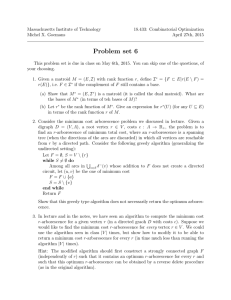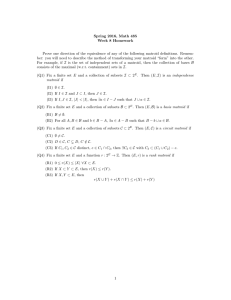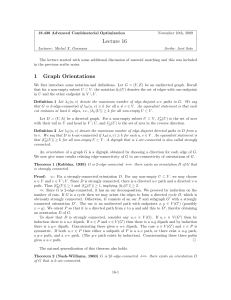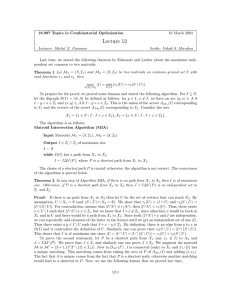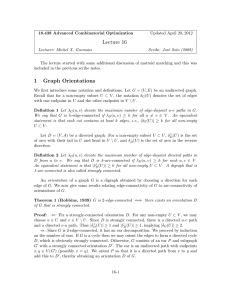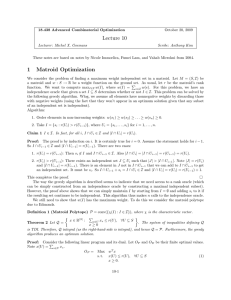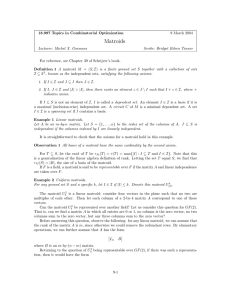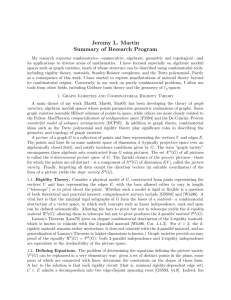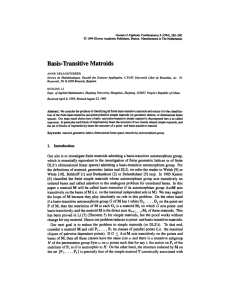Lecture 12
advertisement
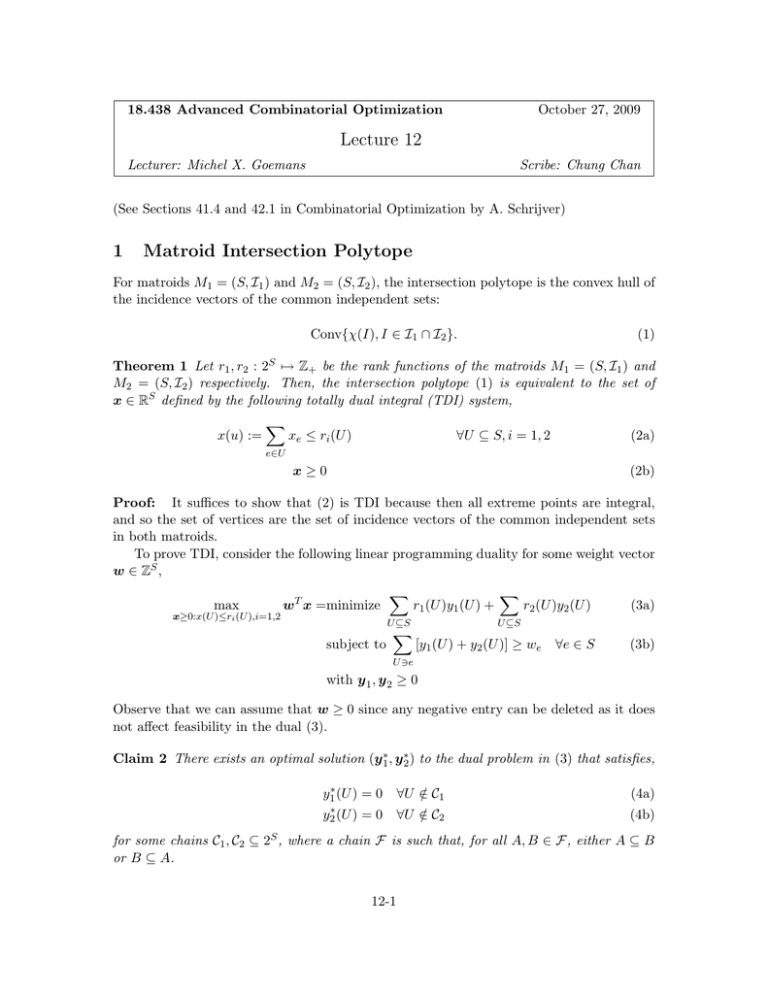
18.438 Advanced Combinatorial Optimization
October 27, 2009
Lecture 12
Lecturer: Michel X. Goemans
Scribe: Chung Chan
(See Sections 41.4 and 42.1 in Combinatorial Optimization by A. Schrijver)
1
Matroid Intersection Polytope
For matroids M1 = (S, I1 ) and M2 = (S, I2 ), the intersection polytope is the convex hull of
the incidence vectors of the common independent sets:
Conv{χ(I), I ∈ I1 ∩ I2 }.
(1)
Theorem 1 Let r1 , r2 : 2S 7→ Z+ be the rank functions of the matroids M1 = (S, I1 ) and
M2 = (S, I2 ) respectively. Then, the intersection polytope (1) is equivalent to the set of
x ∈ RS defined by the following totally dual integral (TDI) system,
x(u) :=
X
xe ≤ ri (U )
∀U ⊆ S, i = 1, 2
(2a)
e∈U
x≥0
(2b)
Proof: It suffices to show that (2) is TDI because then all extreme points are integral,
and so the set of vertices are the set of incidence vectors of the common independent sets
in both matroids.
To prove TDI, consider the following linear programming duality for some weight vector
w ∈ ZS ,
max
wT x =minimize
x≥0:x(U )≤ri (U ),i=1,2
X
r1 (U )y1 (U ) +
U ⊆S
subject to
X
X
r2 (U )y2 (U )
(3a)
U ⊆S
[y1 (U ) + y2 (U )] ≥ we
∀e ∈ S
(3b)
U 3e
with y 1 , y 2 ≥ 0
Observe that we can assume that w ≥ 0 since any negative entry can be deleted as it does
not affect feasibility in the dual (3).
Claim 2 There exists an optimal solution (y ∗1 , y ∗2 ) to the dual problem in (3) that satisfies,
y1∗ (U ) = 0
∀U ∈
/ C1
(4a)
y2∗ (U )
∀U ∈
/ C2
(4b)
=0
for some chains C1 , C2 ⊆ 2S , where a chain F is such that, for all A, B ∈ F, either A ⊆ B
or B ⊆ A.
12-1
Proof: Let (y ∗1 , y ∗2 ) be an optimal solution to the dual in (3). Fixing y 2 = y ∗2 , the
optimization becomes
X
X
minimize
r1 (U )y1 (U )+
r2 (U )y2∗ (U )
U ⊆S
subject to
U ⊆S
X
y1 (U ) ≥ we −
U 3e
X
y2∗ (U )
∀e ∈ S
U 3e
|
{z
(1)
}
we :=
with y 1 ≥ 0
This boils down to the linear programming dual of the maximum independent set problem
with weight w(1) . Thus, by the proof of the matroid polytope given in a previous lecture,
the optimal solution y ∗1 can be chosen to be a chain. Similarly, by now fixing y 1 = y ∗1 , the
optimal solution y ∗2 can also be chosen to be a chain. Furthermore, they satisfy
X
y1∗ (U ) = we(1)
(5a)
y2∗ (U ) = we(2)
(5b)
U ∈C1 :U 3e
X
U ∈C2 :U 3e
and hence,
2 X
X
y1∗ (U ) = we ,
i=1 U ⊆S
for all e ∈ S.
The above claim shows that we can restrict our attention to the union of two chains.
We now show that even if we restrict only to the union of two laminar familar families then
the underlying matrix is totally unimodular, which will allow us to derive integrality.
Claim 3 Let C1 and C2 be two laminar families of 2S . i.e. for i = 1, 2,
A, B ∈ Ci =⇒ A ∩ B = ∅ or A ⊆ B or B ⊆ A.
(6)
Then, S × (C1 , C2 )-incidence matrix M is totally unimodular (TU). i.e. for all square
submatrices B,
det(B) ∈ {0, ±1}.
(7)
Proof: After elementary column operations on M (subtract from the column corresponding to a set A all columns corresponding to maximal sets contained in A), it follows from
laminarity that we can transform the incidence matrix (without modifying the determinant
of any square submatrix) into one such that every row has at most one “1” within columns
in C1 , and one “1” within columns in C2 . (7) can be argued case by case as follows:
1. There is an all-zero row. The determinant is 0.
12-2
2. Every row has two “1”’s. The determinant is 0 since the sums over the columns in C1
and C2 are the same, namely 1.
3. There is a row with one “1”. Computing the determinant by expanding along that
row, we have (7) by induction.
By Claim 2, without loss of optimality, we can restrict our dual program to the variables
corresponding to the two chains C1 and C2 which gives,
minimize
X
r1 (U )y1 (U ) +
U ∈C1
subject to ,
X
X
(8a)
r2 (U )y2 (U )
U ∈C2
X
y1 (U ) +
U ∈C1 :e∈U
y2 (U ) ≥ we
∀e ∈ S
(8b)
U ∈C2 :e∈U
with y1 (U ) ≥ 0 for ∀U ∈ C1 , y2 (U ) ≥ 0 for ∀U ∈ C2 .
We now argue that this linear program is integral. Indeed, its extreme points are obtained
by solving some subsystem By = w0 where B is a square submatrix of the (S × (C1 , C2 ))incidence matrix M with integral weights w0 . Since M is TU by Claim 3, the solution y
is integral as desired.
Remark 1
1. There is a good characterization of TU matrices. Seymour [2] gives an
efficient polynomial time algorithm to verify if a matrix is TU by providing a decomposition result for regular matroids (which are precisely those matroids representable
over R by columns of a TU matrix).
2. The result (Claim 3) does not extend to the union of three chains, and thus not to the
intersection of three matroids.
3. Since the constraints for the dual can be replaced by the equalities (5), we have (8)
equal
min
max w1 (I) + max w2 (I)
w1 ,w2 ∈ZS
+:
w=w1 +w2
I∈I1
I∈I2
This is known as weight-splitting, and gives a good characterization for the primal
problem.
4. Cunningham [1] gives a strongly polynomial time algorithm for the separation problem:
given x ∈ QS , find U that maximizes x(U ) − rM (U ) for matroid M with rank function
rM . (This is a special case of submodular function minimization.) This also gives an
efficient way to test if x belongs to the intersection polytope of two matroids, and to
decompose x as a convex combination of the incidence vectors in the polytope.
12-3
2
Matroid Union
Consider k matroids, Mi = (Si , Ii ) for i = 1, . . . , k. Define
S=
I=
k
[
Si ,
i=1
( k
[
)
Ii : Ii ∈ Ii
i ∈ [k] .
i=1
Theorem 4 M1 ∨ M2 ∨ · · · ∨ Mk = (S, I) is a matroid with rank function
"
rM = min |U \T | +
T ⊆U
k
X
#
ri (T ∩ Si ) .
(9)
i=1
This is proved using the following Lemma.
Lemma 5 Let M̂ = (Ŝ, Î) be any matroid (e.g., the union of k matroids M̂i = (Ŝi , Îi ) with
i = 1, . . . , k and Ŝi disjoint). For any f : Ŝ 7→ S, we have (S, I) is a matroid where
ˆ : Iˆ ∈ Î}.
I := {f (I)
(10)
Furthermore, its rank function is given by
rM (U ) = min rM̂ (f −1 (T )) + |U \T | .
T ⊆U
Proof of Lemma 5:
(11)
Consider I ∈ I. Then there exists some Iˆ ∈ Î such that,
ˆ and |I| = |I|.
ˆ
I = f (I)
Any subset of I is independent since it can be expressed as the image under f of some
subset of Î.
ˆ ∈ I for some Jˆ ∈ Î such that
Consider in addition that J = f (J)
ˆ < |J|
ˆ = |J|.
|I|
(12)
This implies
Iˆ + e ∈ Î
ˆ I.
ˆ
for some e ∈ J\
(13)
ˆ = I, |I|
ˆ = |I|) to attain
Assume further that Iˆ is chosen (among those with Iˆ ∈ Î, f (I)
ˆ
max|Iˆ ∩ J|.
Iˆ
(14)
Then, we will argue that f (e) ∈
/ I, which gives the desired existence of z ∈ J\I, namely
z = f (e), such that I + z ∈ I. Suppose to the contrary that f (e) ∈ I ∩ J. Thus there exists
12-4
e0 ∈ Iˆ \ Jˆ : f (e0 ) = f (e). Observe that Iˆ0 := Iˆ + e − e0 ∈ Î by (13), and furthermore that
ˆ = |Iˆ ∩ J|
ˆ + 1 by (13), which contradicts the optimality of Iˆ in (14).
f (Iˆ0 ) = I. But |Iˆ0 ∩ J|
To derive the
−1
rank function rM in (11), define the partition matroid (Ŝ, Ip ) induced by
f (e) : e ∈ U for some U ⊆ S as follows,
Ip := {I ⊆ Ŝ : |f −1 (e) ∩ I| ≤ 1 ∀e ∈ U, |f −1 (e) ∩ I| = 0 ∀e ∈
/ U}
(15)
which has rank function
rMp (T ) = {e ∈ U : f −1 (e) ∩ T 6= ∅} .
(16)
Then, I is an independent set of M in U iff there is a subset Iˆ ⊆ Û := f −1 (U ) independent
in both Mp and M̂ . Thus,
ˆ
max|I| = max |I|.
I⊆U
I∈I
ˆ Û
I⊆
ˆ Î∩Ip
I∈
By the matroid intersection theorem, this equality becomes,
i
h
rM (U ) = min rM̂ (T̂ ) + rMp (Û \T̂ )
(17)
T̂ ⊆Û
= min rM̂ (f −1 (T )) + |U \T |
T ⊆U
(18)
where the last equality is because it is optimal to have T̂ of the form f −1 (T ) for some
T ⊆ U . Indeed, if not, defining T̂ 0 := Û \ f −1 (f (Û \ T̂ )) = f −1 (U \ f (Û \ T̂ )) gives a new
set with (i) T̂ 0 ⊆ T̂ (and hence, rM̂ (T̂ 0 ) ≤ rM̂ (T̂ )), (ii) rMp (Û \T̂ 0 ) = rMp (Û \T̂ ), and (iii)
T̂ 0 = f −1 (T ) for T = U \ f (Û \ T̂ ).
Proof of Theorem 4: The case when Si ’s are disjoint is obvious. The case when Si ’s
are not disjoint can reduce to this setting as follows:
1. construct M̂i = (Ŝi , Ii ) by relabeling e ∈ Si as (i, e).
2. define f : Ŝ 7→ S as a selector of the second component, namely f ((i, e)) = e.
By (11), we have,
rM (U ) = min rM̂ (f −1 (T )) + |U \T |
T ⊆U
" k
#
X
−1
= min
rM̂ (f (T ) ∩ Ŝi ) + |U \T |
T ⊆U
i=1
since Ŝi ’s are disjoint. This gives the desired rank function (9) since rM̂ (f −1 (T ) ∩ Ŝi ) =
rM (T ∩ Si ).
References
[1] W.H. Cunningham, “Testing maembership in matroid polyhedra”, Journal of Combinatorial Theory, Series B, 36, 181–188, 1984.
[2] P.D. Seymour, “Decomposition of regular matroids”, Journal of Combinatorial Theory,
Series B, 28, 305–359, 1980.
12-5

